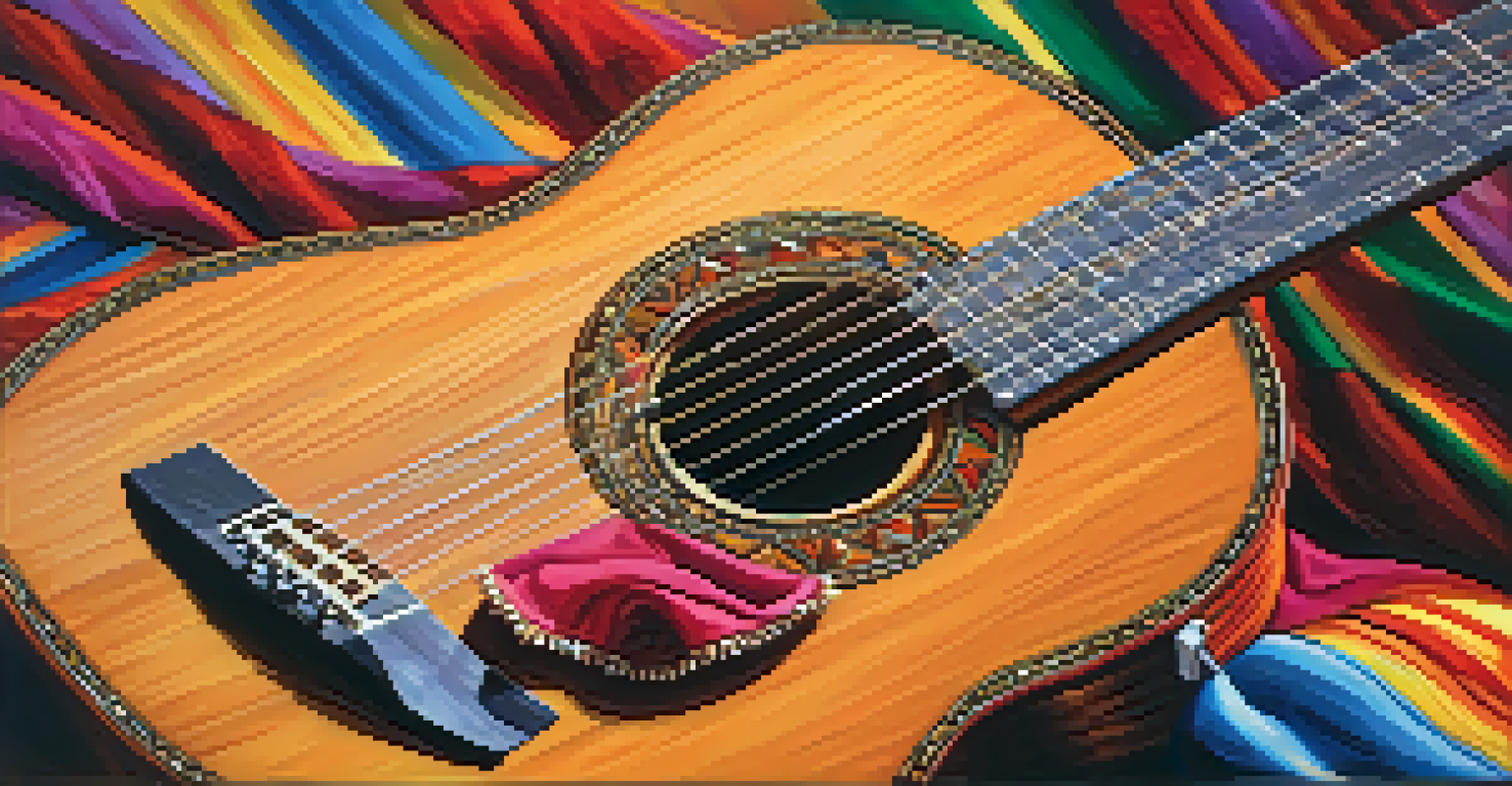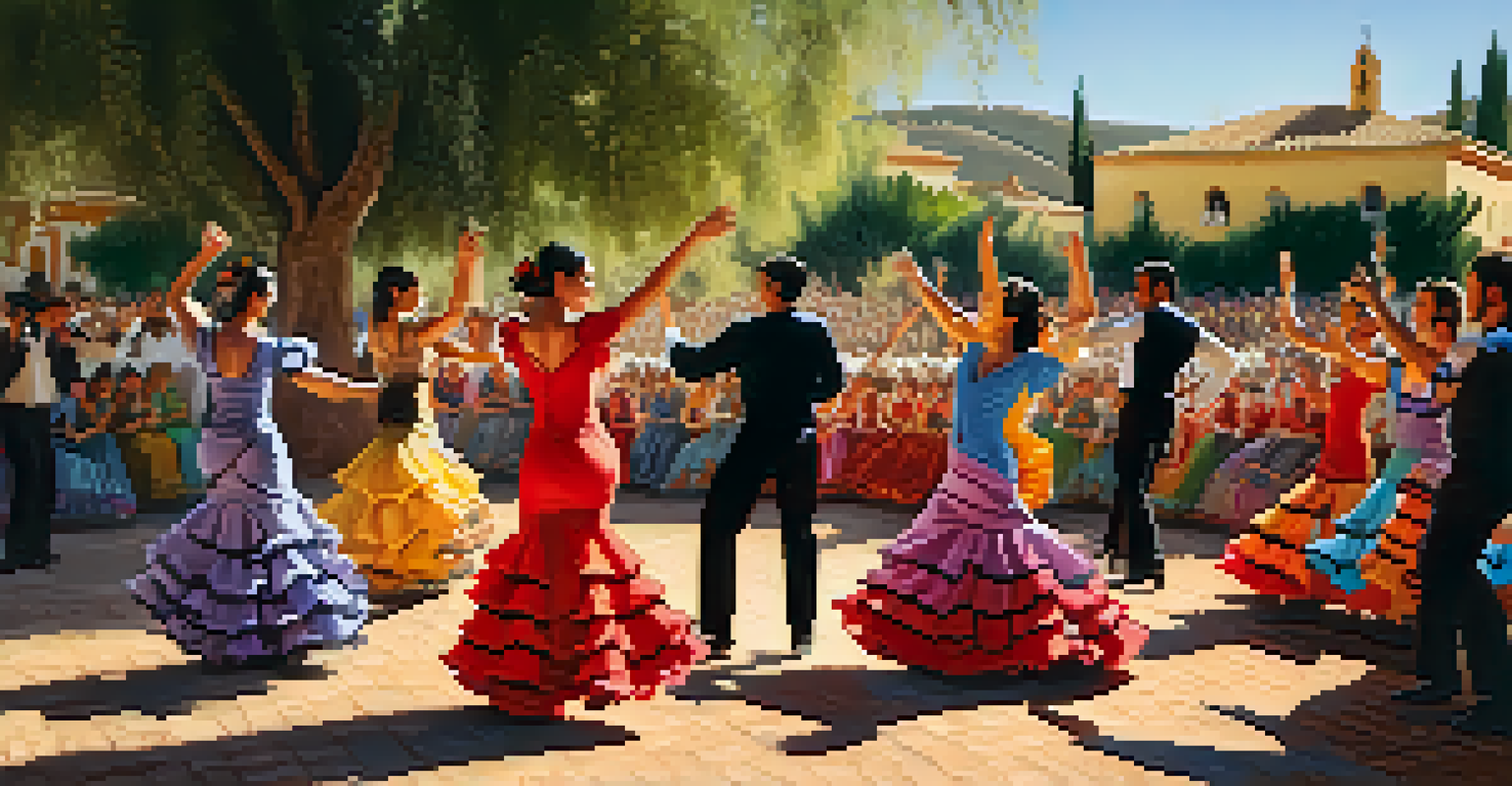The Influence of Flamenco on Guitar Techniques Worldwide

The Rich History of Flamenco and Its Guitar Roots
Flamenco, a passionate and expressive art form, originated in the Andalusian region of Spain. Its roots can be traced back to a blend of cultures, including Romani, Moorish, and Jewish influences. This vibrant history has shaped not only the music but the guitar techniques that accompany it, making Flamenco a unique genre in the world of music.
Flamenco is the most personal and expressive of all music, as the guitar speaks the emotions of the soul.
The guitar in Flamenco is more than just an instrument; it acts as a storyteller, complementing the singing and dancing. Techniques like 'rasgueado' (strumming) and 'alzapúa' (thumb technique) are integral to Flamenco, showcasing the intricate relationship between the musician and the performance. These techniques have inspired countless guitarists across various genres worldwide.
As Flamenco spread beyond Spain, its guitar techniques began to influence musicians globally. The emotional depth and technical prowess displayed in Flamenco guitar became a source of inspiration for artists looking to add flair and complexity to their own music, creating a ripple effect across genres.
Key Flamenco Techniques That Transcended Borders
One of the most prominent techniques is 'picado,' a rapid, alternate picking method that creates a bright, articulate sound. This technique became popular among classical guitarists, who admired its precision and speed. The influence of picado can be seen in various styles, from classical to rock, as guitarists strive to incorporate its dynamic quality.

Another technique, 'tremolo,' involves rapidly repeating a single note, producing a hauntingly beautiful effect. This technique has found its way into many genres, including classical and folk music. Guitarists use tremolo to evoke emotion and create tension, showcasing the versatility of Flamenco techniques.
Flamenco: A Cultural Melting Pot
Flamenco's origins are rooted in a blend of Romani, Moorish, and Jewish cultures, making it a vibrant expression of diverse influences.
The 'flamenco golpe,' or tapping on the guitar body, adds a percussive element to the music. This technique has inspired guitarists in genres like jazz and pop, where rhythm plays a crucial role. By incorporating golpe, musicians can create a fuller sound, enriching their compositions and performances.
Flamenco's Influence on Classical Guitarists
Many classical guitarists have drawn inspiration from Flamenco, incorporating its techniques into their repertoire. Renowned players like Andrés Segovia and John Williams have explored Flamenco's rich textures, blending them with classical styles. This fusion has expanded the boundaries of classical guitar music, inviting new audiences to appreciate its complexity.
The guitar is a miniature orchestra in itself.
The emotional expressiveness inherent in Flamenco has also encouraged classical guitarists to adopt a more passionate playing style. By studying Flamenco, these musicians have learned to convey deep emotions through their performances, elevating their artistry to new heights. This emotional connection resonates with audiences, making performances more memorable.
Moreover, Flamenco's rhythmic patterns, such as 'compás,' have intrigued classical guitarists, leading them to experiment with intricate rhythms in their compositions. This blending of styles not only enriches classical music but also celebrates the cultural exchange between genres.
The Impact of Flamenco on Contemporary Music
Flamenco's influence isn't limited to classical music; it has permeated contemporary genres as well. Artists like Paco de Lucía and Vicente Amigo have brought Flamenco to the forefront of modern music, inspiring a new generation of guitarists. Their innovative approaches showcase how Flamenco techniques can be adapted to various musical landscapes.
In genres like rock and jazz, guitarists often incorporate Flamenco elements to add flair and complexity. For example, the use of Flamenco strumming patterns can create a distinct sound that sets a song apart. This cross-pollination of styles highlights the adaptability of Flamenco techniques in contemporary music.
Techniques Influencing Global Music
Flamenco guitar techniques like 'picado' and 'tremolo' have transcended borders, inspiring musicians across various genres and enhancing their compositions.
Additionally, collaborations between Flamenco musicians and artists from other genres have resulted in unique musical fusions. These partnerships not only celebrate the richness of Flamenco but also showcase how its techniques can enhance and transform modern music.
Flamenco in World Music and Global Fusion
As musicians around the world embrace Flamenco, its techniques have sparked the creation of global fusion genres. From Latin pop to world music, artists are blending Flamenco's rhythmic and melodic elements with diverse cultural influences. This fusion not only celebrates the beauty of Flamenco but also showcases its universal appeal.
The rise of world music festivals has further amplified Flamenco's global presence. Musicians from different backgrounds come together to celebrate their unique heritages, often incorporating Flamenco techniques into their performances. This collective exploration has led to innovative sounds and exciting collaborations that captivate audiences worldwide.
In this way, Flamenco serves as a bridge, connecting cultures through music. Its techniques invite musicians to experiment and collaborate, creating a rich tapestry of sound that reflects the diversity of human expression.
The Role of Education in Spreading Flamenco Techniques
Education plays a crucial role in preserving and promoting Flamenco guitar techniques. Institutions around the world are recognizing the importance of incorporating Flamenco into their guitar programs. This not only helps students learn traditional techniques but also encourages them to explore their own creativity.
Workshops and masterclasses led by Flamenco musicians allow aspiring guitarists to immerse themselves in the art form. These sessions provide invaluable insights into techniques like 'rasgueado' and 'alzapúa,' fostering a deeper understanding of the music. As students learn from masters, they carry these techniques forward into their own playing.
Education's Role in Flamenco's Future
Education and online resources are crucial for preserving Flamenco techniques, allowing new generations of musicians to learn and innovate within this art form.
Online platforms and resources have also made Flamenco techniques more accessible. Aspiring musicians can now find tutorials, courses, and communities dedicated to Flamenco guitar, allowing them to learn at their own pace. This democratization of knowledge ensures that Flamenco continues to thrive and evolve in the hands of new generations.
Celebrating Flamenco's Enduring Legacy in Guitar Music
The legacy of Flamenco is evident in the diverse array of guitar styles that exist today. Its techniques have transcended cultural boundaries, influencing musicians across genres and continents. This enduring impact speaks to the universal language of music and the power of cultural exchange.
As guitarists continue to explore and innovate, they honor the traditions of Flamenco while paving the way for new interpretations. The fusion of Flamenco techniques with contemporary styles is a testament to the genre's resilience and adaptability. This evolution ensures that Flamenco remains relevant in today's musical landscape.

Ultimately, the influence of Flamenco on guitar techniques worldwide is a celebration of creativity and artistry. Its rich history and vibrant techniques inspire musicians to express themselves, creating a dynamic musical dialogue that resonates with audiences everywhere.